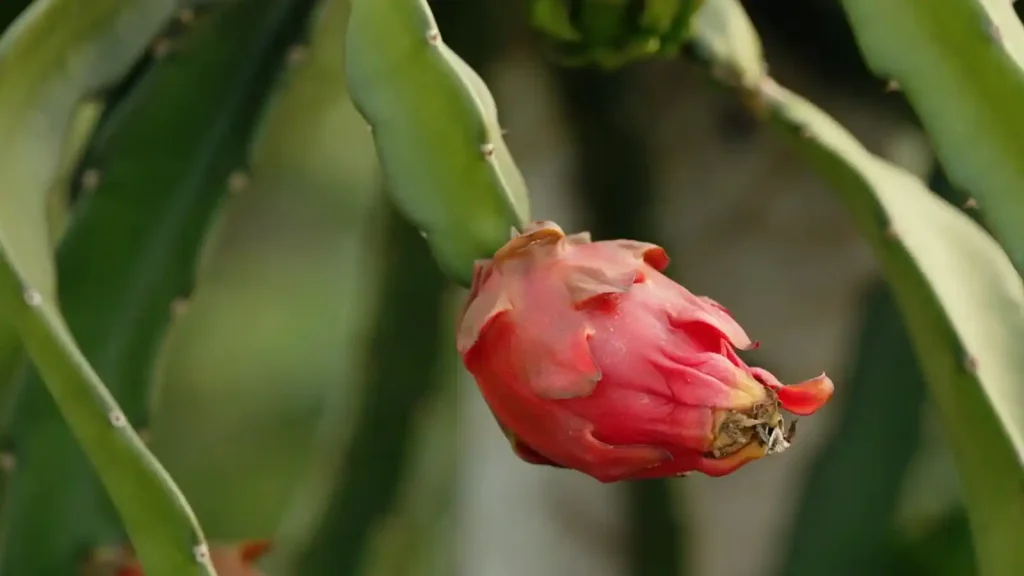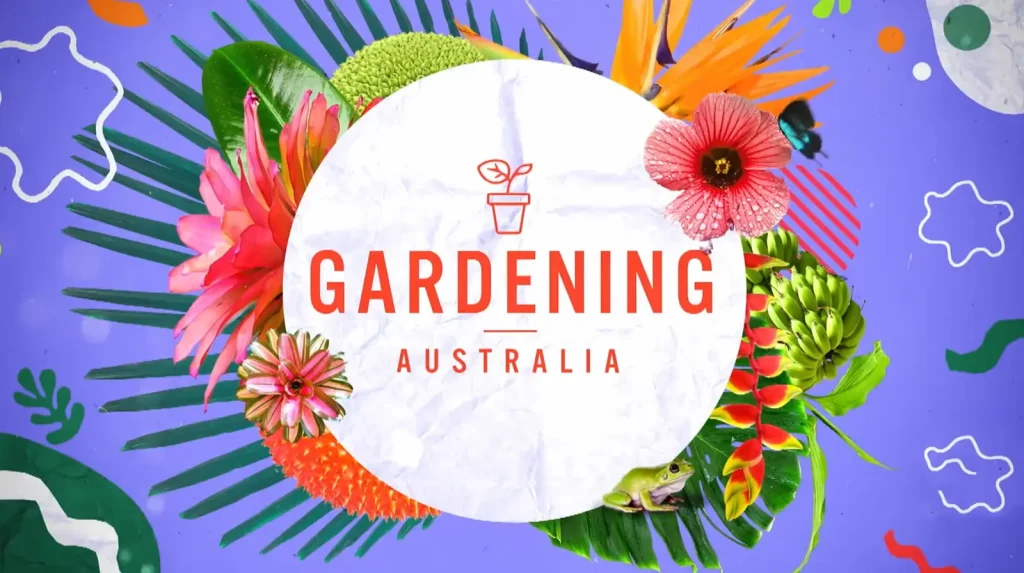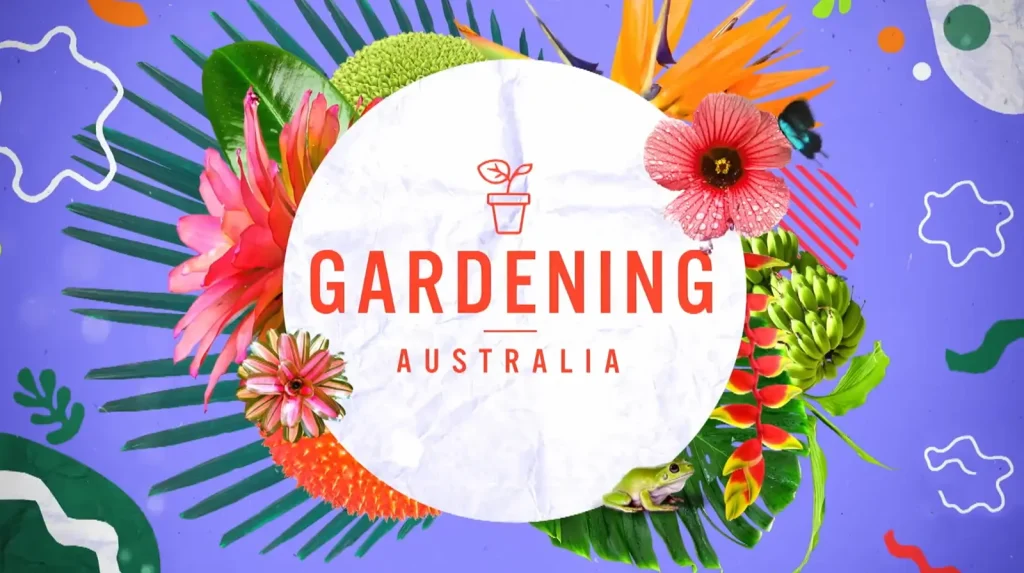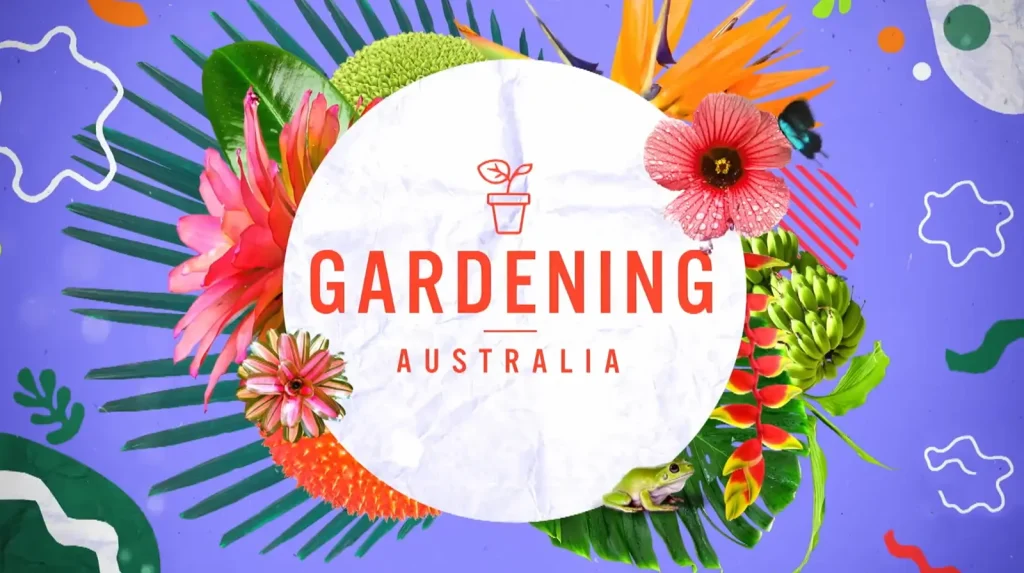In Gardening Australia 2024 episode 21 takes viewers on a horticultural journey exploring unique flora and inspired craftsmanship. This episode unfurls a rich tapestry of stories that converge on the shared theme of nature’s adaptability and aesthetic splendor, offering both visual delight and practical advice. The episode opens with Jerry’s enlightening excursion to a lush tropical fruit tree nursery. Here, viewers are treated to a vibrant display of exotic fruit-bearing trees, some of which are surprisingly well-suited to colder climates. Jerry provides in-depth insights into the cultivation techniques that enable these tropical species to thrive in less-than-tropical environments, along with tips on how home gardeners can replicate these conditions.
Transitioning from the tropical to the native, we next follow Millie as she explores the understated beauty of flowering plants nestled under the canopy of towering gum trees. Millie discusses the symbiotic relationships between the native flora and how gardeners can utilize these dynamics to enhance their own garden spaces. Her segment focuses on selecting the right species that not only grow well in the shaded understory but also contribute to the biodiversity of the garden ecosystem.
Midway through the episode, Tammy introduces viewers to an expert in aroids, a family of plants known for their dramatic foliage and striking appearance. This expert shares his extensive knowledge on the care and propagation of these fascinating plants, highlighting varieties that perform well in cooler climates. Tammy’s visit is packed with practical advice for enthusiasts looking to add a touch of the exotic to their plant collections.
Jane’s segment shifts the focus to the serene beauty of conifers. She showcases a variety of conifers that provide year-round interest and are particularly striking in the winter landscape. From the majestic pines to the dwarf spruces, Jane explains how these evergreens can serve as the backbone of a garden, offering both structure and a steady palette of greens through the frosty months.
Finally, the episode culminates with a captivating feature on a local jeweller who draws her inspiration from the natural world. Her designs reflect the intricate details of her native garden, translating the organic forms of leaves, flowers, and branches into wearable art. This segment not only celebrates the intersection of nature and artistry but also encourages viewers to see the garden as a muse for creative endeavors.
Throughout, “Gardening Australia 2024 – Episode 21: Exotic Fruits & Cool Conifers” not only educates its audience on diverse gardening practices and plant types but also connects them to broader themes of ecological awareness and artistic inspiration. The episode serves as a reminder of the endless possibilities that gardening offers for enhancing our surroundings and enriching our lives.
Gardening Australia 2024 episode 21
The Allure of Exotic Fruits and Tropical Treasures
Setting the Scene: Jerry’s Visit to Daleys Nursery
Imagine stepping into a world where the air is thick with the sweet scent of ripe fruits, and every turn reveals a new, tantalizing treasure. This is the experience that awaits Jerry as he embarks on his journey to Daleys Nursery. Nestled in the heart of Kyogle, this horticultural haven is a veritable Willy Wonka’s Chocolate Factory for fruit enthusiasts.
As Jerry approaches the nursery, his senses are immediately awakened. The vibrant colors of exotic fruits peek out from lush foliage, while the gentle hum of bees busy at work fills the air. It’s a sensory overload that ignites a spark of excitement in even the most seasoned gardener. For Jerry, this visit is more than just a day trip; it’s the fulfillment of a long-held dream, a chance to explore the cutting edge of subtropical fruit cultivation.
The Subtropical Paradise: Kyogle’s Unique Climate
Kyogle, a hidden gem nestled about 90 kilometers inland from Byron Bay, boasts a climate that’s nothing short of magical for fruit growers. This little pocket of New South Wales is a subtropical oasis, cradled by spectacular rainforests and shielded from harsh coastal winds by the majestic Great Dividing Range. It’s as if Mother Nature herself designed this spot with fruit cultivation in mind.
The unique microclimate of Kyogle creates a perfect storm of conditions for growing exotic fruits. Warm, humid summers coupled with mild winters provide an ideal environment for plants that might struggle in other parts of Australia. This climatic sweet spot allows gardeners and farmers to push the boundaries of what’s possible, coaxing tropical delights from the earth in a region that, by all rights, should be too far south for such endeavors.
Teasing the Senses: A Glimpse into the World of Exotic Fruits
As we delve deeper into Daleys Nursery, we’re greeted by a cornucopia of fruits that seem to have leapt straight from the pages of a fantastical storybook. Here, the ordinary lemon tree of the average Aussie backyard gives way to a parade of exotic wonders. Mamey sapotes with their salmon-colored flesh, dragon fruits in shades of vibrant pink, and the tangy Bolivian achacha are just the tip of the iceberg.
Each fruit tells a story of adventure and discovery. They whisper tales of far-off lands and ancient traditions, now finding new life in Australian soil. The allure of these exotic fruits lies not just in their unusual flavors and appearances, but in the challenge they present to growers. They beckon to the adventurous spirit in every gardener, daring them to try something new, to push beyond the familiar and into exciting new territory.
As we stand on the threshold of this exotic fruit paradise, we can’t help but feel a surge of excitement. What treasures will we uncover? What new flavors will dance across our tongues? And most importantly, how can we bring a piece of this tropical wonder back to our own gardens? The journey into the world of exotic fruits is about to begin, and it promises to be a thrilling ride indeed.
Discovering Rare and Delicious Exotic Fruits
Mamey Sapote: A Creamy Caramel Delight
Imagine biting into a fruit that tastes like a cross between sweet potato pie and butterscotch pudding. That’s the mamey sapote for you – a tropical treasure that’s as intriguing as it is delicious. This Central American native, with its rough brown exterior and salmon-colored flesh, is a true gem in the world of exotic fruits.
But what makes the mamey sapote truly remarkable is its ability to adapt to subtropical conditions. Despite its tropical origins, this resilient fruit has found a home in Kyogle’s unique climate. It’s a testament to nature’s flexibility and the ingenuity of horticulturists who’ve coaxed this tropical delight into thriving in cooler climes.
Origin and Adaptation to Subtropical Conditions
The mamey sapote’s journey from Central American jungles to Australian orchards is nothing short of miraculous. Originally found in the lush, humid forests of Mexico and Central America, this fruit has managed to adapt to the subtropics with surprising ease. The key to its success lies in its ability to withstand short periods of cooler temperatures, a trait that has made it a favorite among adventurous growers in Kyogle.
In its native habitat, the mamey sapote tree can grow up to 40 meters tall. However, in subtropical regions, it’s often kept to a more manageable size through careful pruning. This not only makes harvesting easier but also allows the tree to focus its energy on fruit production rather than excessive growth.
Growing Mamey Sapote in Different Climates
While the mamey sapote thrives in Kyogle’s subtropical paradise, it’s not limited to this region alone. Enterprising gardeners across Australia are pushing the boundaries of what’s possible, cultivating this exotic fruit in various climates. The secret? Creating microclimates that mimic the fruit’s native conditions.
In cooler regions, growing mamey sapote becomes an exciting challenge. Gardeners use techniques like planting against north-facing walls to maximize sun exposure or employing polyhouses to create a warmer environment. With a bit of creativity and care, even gardeners in places like Sydney might find success in growing this tropical treat.
Dragon Fruit: Beyond the Ordinary
Just when you thought you knew everything about dragon fruit, along comes a variety that turns expectations on their head. Enter the ‘Pink Panther’ – a dragon fruit variety that’s as intriguing as its feline namesake. This isn’t your run-of-the-mill dragon fruit; it’s a flavor sensation that’s taking the exotic fruit world by storm.
The ‘Pink Panther’ dragon fruit is a testament to the endless possibilities in fruit breeding. It combines the best of both worlds – the striking appearance of traditional dragon fruit with a flavor profile that will make your taste buds dance with joy. It’s a fruit that proves there’s always room for innovation, even in well-established favorites.
Introducing the ‘Pink Panther’ Variety
The ‘Pink Panther’ variety of dragon fruit is a game-changer in the world of exotic fruits. Unlike its more common cousins, this variety boasts a compact growth habit, making it perfect for backyard growers with limited space. But don’t let its smaller size fool you – what it lacks in stature, it more than makes up for in flavor and productivity.
One of the most striking features of the ‘Pink Panther’ is its vibrant pink flesh. Cut it open, and you’re greeted with a color so intense it almost seems artificial. But there’s nothing fake about this fruit – it’s 100% natural and 100% delicious. The compact nature of the plant also means you can create lower trellises, making cultivation and harvesting a breeze.
Flavor Profile and Cultivation Tips
Now, let’s talk flavor. Where traditional dragon fruits can sometimes be a bit bland, the ‘Pink Panther’ is anything but. Take a bite, and you’ll be hit with a burst of sweetness followed by subtle berry notes. It’s like nature decided to combine the best parts of a raspberry and a kiwi, then wrap it all up in a dragon fruit package.
Growing the ‘Pink Panther’ is a joy for both novice and experienced gardeners. This variety is self-pollinating, meaning you only need one plant to get fruit. It’s also highly productive from a young age, so you won’t have to wait years to enjoy your first harvest. To get the best results, provide your dragon fruit with well-draining soil, plenty of sunlight, and a sturdy support structure for it to climb.
Achacha: Bolivia’s Tangy Treasure
Last but certainly not least, we come to the achacha – a fruit that’s as fun to say as it is to eat. Hailing from the Bolivian Amazon, this little-known fruit is making big waves in the world of exotic produce. With its tangy-sweet flavor and unique eating experience, the achacha is quickly becoming a favorite among fruit enthusiasts.
The achacha is a testament to the vast diversity of fruits that exist in the world’s tropical regions. It’s a reminder that there’s always something new to discover, even for the most seasoned fruit connoisseur. And now, thanks to the efforts of passionate growers, this Bolivian treasure is finding a new home in Australian soil.
Unique Characteristics and Eating Experience
The achacha is a fruit that demands attention. Its bright orange shell houses a translucent white pulp that’s both refreshing and flavorful. But the real fun begins when you try to open it. Unlike other fruits that you simply peel or cut, the achacha requires a specific technique. You need to gently score the skin with your fingernail and then pop it open – it’s almost like unwrapping a tiny, delicious present.
Once you’ve mastered the art of opening an achacha, you’re in for a treat. The flavor is often described as a cross between a lychee and a mangosteen, with a perfect balance of sweetness and acidity. It’s refreshing, light, and utterly addictive. Plus, the seeds are edible, adding a pleasant crunch to the overall eating experience.
Pushing Climate Boundaries: Growing Achacha in Cooler Regions
What makes the achacha particularly exciting for Australian growers is its ability to thrive in subtropical conditions. Despite its tropical origins, this hardy fruit has shown remarkable adaptability. In fact, it’s been successfully grown in Kyogle, proving that with the right care and conditions, tropical fruits can flourish in cooler climates.
Growing achacha in subtropical regions requires a bit of patience and know-how. The trees take about seven years to start fruiting, but once they do, they’re incredibly productive. They prefer well-draining soil and full sun exposure. While they can tolerate brief periods of cold, they do best in frost-free areas. For gardeners in cooler regions, growing achacha in a protected area or even in a large pot that can be moved indoors during winter might be the key to success.
Nurturing Exotic Fruits: Techniques and Tips from the Experts
The Art of Grafting: Replicating and Improving Fruit Trees
Grafting is like matchmaking for plants – it’s an art that brings together the best of two worlds to create something truly extraordinary. This age-old technique is the secret behind many of the exotic fruits we enjoy today. It’s how growers take the delicious traits of one tree and combine them with the hardiness of another.
At Daleys Nursery, grafting is more than just a technique; it’s a passion that drives innovation in fruit cultivation. By mastering this skill, they’ve unlocked the potential to grow fruits that would otherwise struggle in the Australian climate. It’s a bit like giving these tropical treasures a passport to thrive in new lands.
Benefits of Grafted Trees vs. Seedlings
When it comes to growing exotic fruits, grafted trees are the superstars of the orchard. Unlike seedlings, which can be unpredictable, grafted trees are like clones of their parent plants. This means you know exactly what you’re getting – the same delicious fruit that made you fall in love with the variety in the first place.
But the benefits don’t stop there. Grafted trees are also precocious performers, often bearing fruit years earlier than their seedling counterparts. Imagine plucking ripe mamey sapotes from your tree in just 2-4 years, rather than waiting up to a decade! This quick turnaround is a game-changer for both commercial growers and backyard enthusiasts.
Step-by-Step Grafting Process
The grafting process at Daleys Nursery is a carefully choreographed dance of precision and patience. It starts with selecting a vigorous rootstock – the foundation of the new tree. This rootstock is chosen for its ability to adapt to local soil conditions and resist diseases.
Next comes the scion – a small cutting from the desired fruit variety. With steady hands and sharp tools, the grafters make precise cuts to join the scion to the rootstock. It’s a delicate operation, akin to microsurgery for plants. The union is then carefully wrapped to protect it as it heals.
Biodome Cultivation: Creating a Permaculture Food Forest
Step into the biodome at Daleys Nursery, and you’ll feel like you’ve been transported to a tropical paradise. This innovative structure is more than just a greenhouse; it’s a living laboratory where the boundaries of fruit cultivation are constantly being pushed.
The biodome is a testament to the power of mimicking natural ecosystems. Here, plants of different heights and needs coexist in harmony, just as they would in a natural forest. It’s a thrilling example of permaculture principles in action, proving that we can work with nature to create abundant, sustainable food systems.
Layered Planting Strategies for Maximum Yield
In the biodome, every inch of space is utilized to its fullest potential. The planting strategy is like a well-orchestrated symphony, with each plant playing its part in the overall composition. Tall fruit trees form the canopy, while shorter bushes and vines fill the mid-layers. Ground-hugging plants carpet the floor, ensuring no sunlight goes to waste.
This layered approach not only maximizes yield but also creates a self-sustaining ecosystem. The diversity of plants helps to naturally control pests and diseases, while the different root systems work together to improve soil health. It’s a brilliant demonstration of how we can grow more food in less space, all while working in harmony with nature.
Pruning and Maintenance in a Controlled Environment
Maintaining the delicate balance in the biodome requires a skilled hand and a keen eye. Regular pruning is essential to keep plants at their optimal size and prevent any one species from dominating. It’s like being a conductor, ensuring each instrument in the orchestra gets its moment to shine.
The controlled environment of the biodome also allows for precise management of temperature and humidity. This means that even in the depths of winter, tropical fruits can continue to thrive. It’s a year-round growing season, providing a steady supply of exotic delights regardless of what’s happening outside.
Cincturing: An Ancient Technique for Modern Fruit Growing
Cincturing, also known as girdling, is an intriguing technique that sounds almost too good to be true. It’s an ancient practice that’s finding new life in the cultivation of exotic fruits. By making a shallow cut around the trunk or branch of a tree, growers can trick it into producing more fruit. It’s like flipping a switch in the tree’s brain, telling it to focus on reproduction rather than growth.
At Daleys Nursery, cincturing is used with care and precision to coax reluctant trees into bearing fruit. It’s particularly useful for trees that are stubbornly vegetative or for encouraging larger fruit size. While it may seem counterintuitive to deliberately injure a tree, when done correctly, cincturing can be a powerful tool in the fruit grower’s arsenal.
How Cincturing Works to Stimulate Fruiting
Cincturing works by interrupting the flow of carbohydrates from the leaves to the roots. This creates a build-up of sugars and growth hormones above the cut, which in turn stimulates flower formation and fruit set. It’s like creating a traffic jam of nutrients, forcing the tree to redirect its energy into fruit production.
The beauty of cincturing is that it can often induce fruiting in young trees that would otherwise take years to bear. For impatient gardeners eager to taste the fruits of their labor, this technique can be a game-changer. However, it’s important to note that cincturing is a powerful tool that should be used judiciously to avoid stressing the tree.
Proper Timing and Execution of Cincturing
Timing is everything when it comes to cincturing. The best time to perform this technique is during the growing season, typically from late spring to autumn. This is when the tree is actively moving nutrients and has the energy to respond to the treatment.
The execution of cincturing requires a steady hand and the right tools. A special girdling knife or a sharp, clean blade is used to make a shallow cut around the circumference of the branch or trunk. The cut should only be deep enough to penetrate the bark and reach the cambium layer – go too deep, and you risk seriously damaging the tree. It’s a delicate balance, much like walking a tightrope between stimulating fruit production and harming the tree.
F.A.Q. Gardening Australia 2024 episode 21
Q.: What are the benefits of introducing exotic fruits to Australian gardens, as showcased in Gardening Australia 2024 Episode 21?
A.: Introducing exotic fruits to Australian gardens can expand biodiversity, introduce new flavors and textures to local diets, and can be a rewarding challenge for hobbyists and professional gardeners alike. These plants often attract beneficial insects and birds, enhancing local ecosystems. Furthermore, they can offer year-round visual interest and diversify gardening activities.
Q.: How do tropical fruit trees, like those explored at Daleys Nursery, adapt to less tropical environments?
A.: Tropical fruit trees can adapt to cooler climates through specific cultivation techniques. These include choosing suitable microclimates within the garden, utilizing protective measures against cold, and selecting or breeding varieties that are more tolerant of temperature variations. Techniques such as using greenhouses or planting near heat-retaining structures can also help.
Q.: What advice does Gardening Australia offer for gardeners looking to cultivate aroids in cooler climates?
A.: The episode recommends selecting varieties known for their resilience to cooler temperatures and provides tips on creating optimal growing conditions. This includes ensuring adequate moisture while avoiding waterlogging, using well-draining soil mixes, and providing sufficient but indirect light. Additionally, protecting plants from frost and harsh winter conditions is crucial.
Q.: Why are conifers highlighted as beneficial for winter garden landscapes in the episode?
A.: Conifers are celebrated for their ability to provide structure, color, and life to gardens during the barren winter months. Their evergreen nature means they retain their foliage all year round, offering greenery when most other plants have died back. They also form protective windbreaks, support wildlife, and can reduce soil erosion.
Q.: How does the episode convey the relationship between gardening and creativity?
A.: The episode illustrates this relationship through a feature on a local jeweler who translates the organic forms of her garden into wearable art. This segment underscores the inspiration that nature provides and encourages viewers to perceive their gardens not just as spaces for cultivation but also as muses for artistic expression, fostering a deeper connection with nature.
Throughout, the episode educates its audience on diverse gardening practices and plant types, effectively connecting them to broader themes of ecological awareness and artistic inspiration. It serves as a reminder of the myriad ways that gardening can enrich our surroundings and lives.




